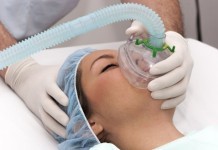 Two things are needed for a spectacular abdominal exam: luck and an abdomen. The following review focuses on different aspects of the abdominal exam, after which you should be more confident than ever to order a CT abdomen/pelvis.
Two things are needed for a spectacular abdominal exam: luck and an abdomen. The following review focuses on different aspects of the abdominal exam, after which you should be more confident than ever to order a CT abdomen/pelvis.
Inspection
When you’re in the produce section of a supermarket, what do you do? Right! You move to the snack aisle. But in the event you grabbed a banana, you would inspect its exterior (in a non-suggestive manner). Same theory applies. First, look for any bruising, scars, rashes, hernias, and aliens sticking out. If the patient has a pannus, check between the folds to look for signs of infection or hidden sandwiches. Next, be sure the abdomen has a sticker with a PLU (product lookup) code so that he or she scans properly at the check-out line. Finally, don’t forget to intensely inspect and scrutinize the belly button: is it an innie or an outie? is it pierced? and if so, where can I get one?
Auscultation
Put your ear on the patient’s abdomen. This conveys a true sense of caring. Do not, however, fall asleep. Things you may hear: stomach growling (or borborygmi), bruits (from vessels such as the aorta), or Lotto numbers (2, 8, 13, 22, 36, 42). Familiarize yourself with the tripoint: a spot just lateral to the xiphoid process used primarily by surgeons to auscultate the heart, lungs, and abdomen simultaneously, which is both lazy and ingenious.
Belly Rub
This maneuver is underutilized, the results of which can provide vital information. If you rub the patient’s belly like a dog and the patient becomes playful and wags its tail, the patient is most likely a dog. If long claws and sharp teeth are embedded into your arm, it’s most likely a cat. Turf the patient, as appropriate, to veterinary or internal medicine.
Percussion
Percussion can help differentiate between gas, solids, and liquids. Rather than using my own fingers to percuss, I prefer drumsticks and treat the abdomen like a snare drum. I would start simple with a 4/4 time signature and slow tempo, maybe 70 beats per minute (adagio). As you percuss with greater skill, then and only then would I recommend moving on to more complex time signatures, fast tempos, and syncopation. Performing a solo abdominal exam prestissimo is difficult and should only be attempted with appropriate supervision.
Punching Bag
Forget palpation. Punch tender locations as much as possible. With each punch, keep asking, “Painful? How about now? How about now?” Be sure to vary the punches: hook, jab, cross, uppercut are just a few options. This will give you an idea of the patient’s abdominal strength and pain tolerance. Prepare to punch lightly first, then to punch deeply. Look for rebound, guarding, and disbelief. The patient will likely be sore after this part of the exam. If he or she requests pain medication, be sure to do the appropriate thing: discharge home.
Liver
This skill requires practice. With two hands, order a right upper quadrant ultrasound and wait on the official read from radiology.
The Spleen
Fictional organ.
Ascites
Shifting dullness occurs when the patient is, irrespective of position, boring. If this happens, find a better patient. The fluid wave is a highly popular maneuver performed during underwater sporting events but often requires thousands of coordinated fans to pull off. When done correctly, however, it looks really cool and might get you on TV.
Rectal Examination
GROSS. Skip this part of the exam. Nothing will ever justify putting a finger or arm into a patient’s rectum. (Shudder.)
Murphy’s Sign
Have the patient relax and breathe out. Put your right hand below the right costal margin. While maintaining pressure, have the patient breathe in. Murphy’s sign is positive if anything that can go wrong, will go wrong. Do not mistake for Murphy’s sigh.
Appendicitis Signs
The view of the appendix from McBurney’s Point is absolutely gorgeous, especially in autumn with all the leaves changing color or at sunset. Bring a camera. To get to McBurney’s Point, follow signs to Rovsing, Psoas, and Obturator.
More Physical Exam Tips below:
– The Heart
– The Lungs
– The Eye
– The Nervous System






